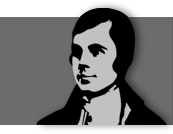The Earnock Manuscripts: MSS 1653-1655
Three volumes of correspondence and papers from 1797 to 1819 — that is, dating from the period immediately after the poet's death — mostly relating to the publication of James Currie's 'Works of Robert Burns with an account of his life' (first to eighth editions). These manuscripts formed part of the office files of Messrs Cadell & Davies until the dissolution of the firm in 1840. They were later acquired by Sir John Watson, Bart, of Earnock, hence their name. These manuscripts were bought in 1936 with the generous help of the Friends of the National Libraries.
MS 1653, a volume of 267 folios, comprises correspondence of Cadell & Davies, Dr James Currie, John McCreery, printer, the Trustees of the estate of Robert Burns, various booksellers and many other interested or relevant parties. The letters cover the period 1797 to 1805. The subject-matter mainly concerns the printing and publication of Currie's work on the poet. The volume includes, towards its end, prints of scenes and places associated with Burns. These include images of Edinburgh, and various locations in Ayrshire and Dumfries.
MSS 1654 and 1655 are essentially two manuscript volumes which form a grangerised copy of R H Cromek's 'Reliques of Robert Burns', fourth edition, 1817. ('Note:' To 'grangerise' means to cut plates and title pages out of many books to form one volume on a particular theme.) These manuscript volumes include further correspondence of Cadell & Davies, Currie, McCreery, Gilbert Burns, Cromek, William Roscoe and others, much of it in continuation of the letters in MS 1653, and date from 1805 to 1819.
The volumes also include material relating to Cromek's scheme for an edition of Burns illustrated by Thomas Stothard, RA, and an eighth edition of Currie, edited by the poet's brother Gilbert. The Stothard drawings include: Burns's fiddle and triangle; the poet's bureau and writing desk; a pastoral scene to illustrate one of the poems (unspecified); and a sketch of the sort of plough with which Burns turned up the mouse and the daisy. (See an image of Stothard's plough sketch in our 'Early years' section.)
The other illustrations include a series of fine printed engravings — many by David Octavius Hill — of some of the principal locations and characters in Robert Burns's life and of those who were instrumental in the early stages of setting the scene for the continuing myth and legend of the poet.

